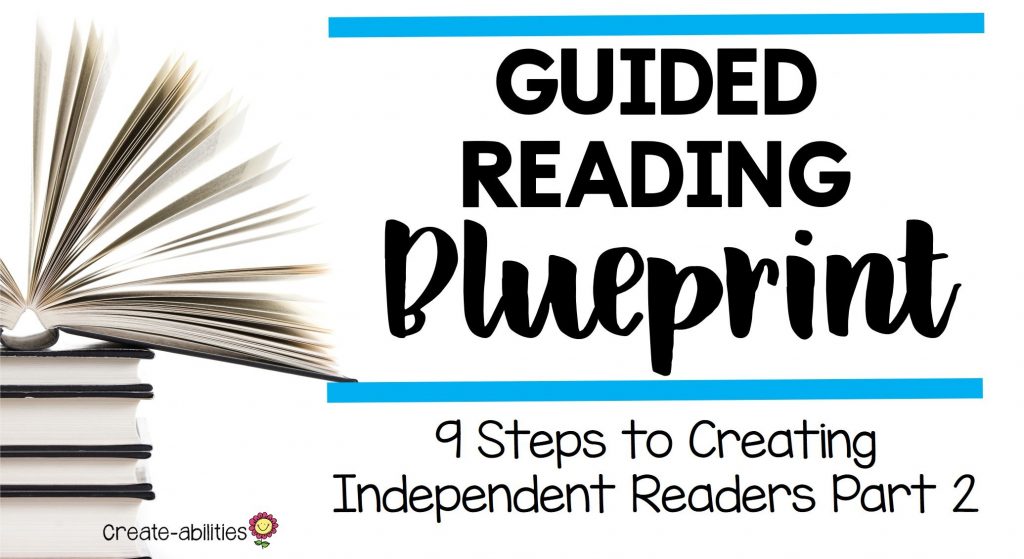
Guided Reading Blueprint: 9 Steps to Creating Independent Readers Part 2
(Missed part one? Catch up here!)
In part one of this blog post series, we talked about grouping students for guided reading, selecting an appropriate text for each group, and how to properly introduce the text. In this post, we’ll get into what to do next, and how to help your students gain as much value as possible from reading the selected text.
Let’s dive in!
4. OBSERVE AND INTERACT WITH STUDENTS
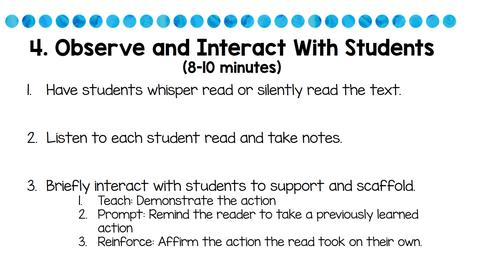
After introducing the text, it’s time for your group to start reading. It’s crucial that your students silent read or whisper read during this time. If you are expected to help them become better independent readers, you need to observe your students while they read independently.
I’ve seen some teachers use this time for popcorn, or choral reading. I’ve wondered so many times myself if that’s what I should be doing. It’s easy to doubt this approach because it’s hard to know if students are making use of this time. However, the more I’ve researched, observed, and experienced, the more I realize how important it is that learners silent read or whisper read during this time.
Start out by making sure each student has their own copy of the book you are reading. I know that this is sometimes difficult to do, and there were indeed times when I had to have two students share a book. Remember to utilize your school and local libraries. Then, follow these steps:
Have students whisper read or silently read the text.
Listen to each student read and take notes. The way I accomplished this was by tapping on the table in front of a student that I was ready to observe. The student knew that this meant that he/she needed to read just loud enough for me to hear. They didn’t change places in the text, they just kept reading where they were.
Part of this step includes monitoring their comprehension. I would usually ask one open-ended question during my 1- to 2-minute interaction with each student. “Why do you think Junie B. Jones did this?” or “How do you think the main character felt?” We might make a prediction. We might infer. Whatever approach I took, I tailored it to the needs of the student.
Briefly interact with students to support and scaffold. This is where the magic happens. During your short interactions with each student, you have an opportunity to model, prompt, and reinforce reading skills and behaviors.
Teach: Demonstrate the action. For example, if you’re trying to help a student focus on finding text-based evidence, you can say something like, “I found on page 22 that the author stated…”
Prompt: Remind the reader to take a previously learned action. For example, you could say, “Do you remember how we made a summary last time? I want you to make a summary this time.”
Reinforce: Affirm the action the reader took on their own. For example, “Oh, I really like how you inferred that information about the main character.”
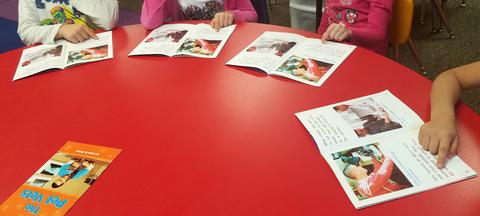
This direct, one-on-one approach to guiding students through a text not only allows you to continually observe and monitor each child’s progress, but it also allows you to teach each student the reading strategies and skills that they uniquely need to learn in order to become skilled independent readers.
Don’t forget to write down what you’re learning about each student as you go. Take running records, or anecdotal notes. You’ll find these notes extremely helpful from day to day or week to week as you attempt to tailor your approach with every student.
So what happens if a student finishes before everyone else in the group? Since you’ve grouped students based on reading proficiency, ideally, this is an uncommon scenario. If one student is often finished minutes before the rest of the group, and they are comprehending the material, that may be a sign that the student is in the wrong group.
When readers do finish early, here are some ideas I’ve seen that can help you fill in the time:
- Have them read the text again. Perhaps give them something to search the text for.
- Have a book box that the kids can draw from. Students can return to the group reading a book of their choice.
- Have them draw a picture of, or write a summary of the book they just read.
5. INVITE STUDENTS TO DISCUSS THE TEXT
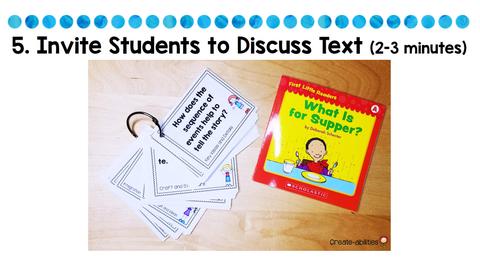
These few minutes of valuable, thought-provoking discussion is crucial for helping things sink in. It’s also a great time to help your readers build comprehension skills and critical thinking skills.
Begin by asking students to comment on the book. This is an open, natural discussion. You are looking for evidence that they have understood what they read. Guide the discussion in a way that encourages deeper thinking so that they can articulate the deeper meanings of the text and any big ideas or messages in the text.
I found that having evidence-based terms displayed in my room really helped my readers learn how to effectively answer questions in an evidence-based approach. I would encourage students to use these terms by modeling how it might be done. While modeling an answer for them, I would point out the terms on the wall that I chose to use. Over time, they’ll see that they can use the posters as a guide to help them effectively answer questions. Eventually, you’ll see that they’ll no longer need the posters, and discussing the text using an evidence-based approach will be natural to them.
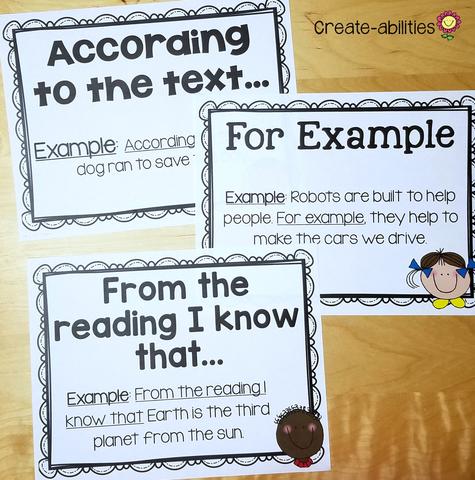
To make this time as instructive as possible, preparation is key. As we’ve discussed in previous steps, it’s important that you write down what you want to ask or say in advance. You’ll find that, when you’re reading a different book with each group, preparing in advance is crucial to a good discussion. Otherwise, if you leave it to in-the-moment inspiration, you’ll come up with a question like, “What color was Harry’s shirt?”
Examples of Questions:
What is important about this story/topic?
Is there another way to think about that?
I hear you saying that ________.
Say more about that.
Let’s return to what we were talking about before.
What makes you think that?
Find an example that shows what you are talking about.
Take us to the part of the story/book that makes you think that.
This part makes me think ________.

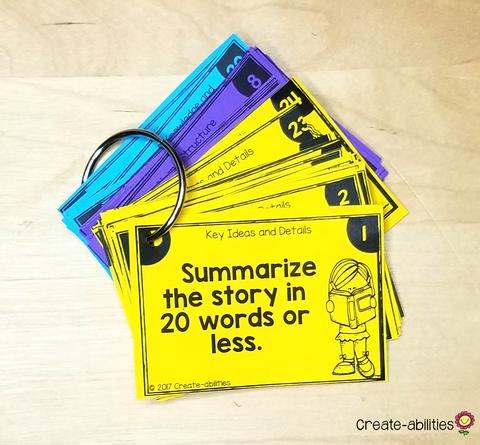
You can see that these questions are generic enough that they can be used with any text. This became an essential tool for me when doing guided reading because it streamlined all my prep work, and helped me focus my time and efforts on teaching effectively.
6. MAKE TEACHING POINTS
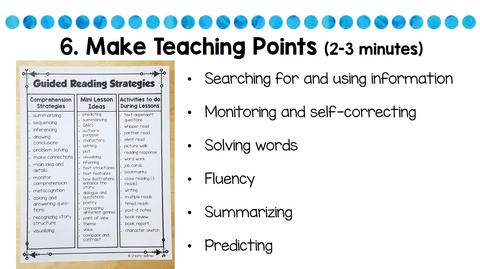
The aim here is not to teach everything to every student every time, but rather to make sure that you have an opportunity to expand on the strategies or skills that support the lesson. Again, preparation is key here. You want to make sure you understand every group well enough that you’re teaching skills that are tailored to the needs of each group.
Here are some skills that you can use for your lessons:
- Searching for and using information
- Monitoring and self-correcting
- Solving words
- Fluency
- Summarizing
- Making connections
- Synthesizing (incorporating new information into what they already know)
- Inferring
- Analyzing and critiquing text
- Predicting
Okay, two down, one to go! Stay tuned for Part 3, where we will talk about supporting activities for guided reading, and how to take what you’ve learned from each guided reading breakout to continue to guide your guided reading groups. (Did you miss Guided Reading Blueprint Part 1? Read more here!)
Want to learn more? Check out my Guided Reading Blueprint: 9 Steps to Creating Independent Readers webinar. It’s completely free and you get a certificate of completion just for attending.
Looking for print and go guided reading materials? I have everything you need for grades K-5. 🙂
Check out What Effective Guided Reading Looks Like here.
PEACE, LOVE, AND STICKY NOTES

Blog Categories
Meet the author


